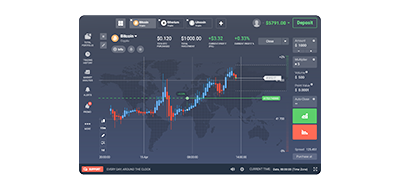Voltar
Contents
What is a Stop Order?

Iva Kalatozishvili
Business Development Manager

Demetris Makrides
Senior Business Development Manager
Stop orders, also known as stop loss orders, is a trading instruction for your broker to buy or sell an asset once it reaches a specific price point level. This order is designed to assist you in protecting your profits or mitigate losses in the event that the market moves against you by automatically initiating a transaction without you having to watch the market constantly. Once the stop price is hit in a trade, a stop order becomes a market order. It gets executed promptly at the best available price.
Understanding How Stop Orders Work
Stop orders are considered a vital tool for managing risks related to trading activities. When an individual sets a stop order in place, they are essentially specifying the price level at which they wish to either sell or purchase their asset and get out of the market should the market trend turn unfavorable.
Once the stop price is achieved, a stop loss order changes to a market order, but it doesn’t ensure a certain price for execution. Alternatively, you may use a stop limit order to restrict the order’s execution to the limit price or a better one; but, if the stock price rapidly swings away from your intended level, the order could not be completed.
Benefits of Stop Orders
Implementing stop orders can offer advantages for traders and investors in terms of risk management and automation of trading positions over different time frames like day trading or long term investing. One key benefit is the ability to protect oneself from losses without the need for constant monitoring of charts. With automatic execution, traders can keep their portfolios protected and manage their risks without having to constantly keep an eye on the market or charts.
One other benefit of stop orders is that they help you protect you effectively by locking in profits when your assets value has increased from when you opened the trade. In situations where the market’s on an upward trend and you wish to keep your position open and continue to ride the move up while still being safeguarded against potential downturns or reversals in the markets direction, using a stop order is perfect. For example, you can do this by setting a stop order. As the market price goes up, you can modify the stop price accordingly to secure gains while also protecting the funds in case of sudden change.
Stop orders provide psychological pluses by eliminating the emotional component from trading decisions that many traders and investors find challenging to navigate on their own—particularly when deciding to sell an asset amidst concerns of potential missed opportunities or the unease of realizing losses prematurely. Implementing a stop order eliminates these factors by implementing a pre-established exit plan that promotes a more structured and logical approach to trading decisions instead of acting on emotions, especially when starting at an unrealized loss. Stop losses are an easy way to add more discipline to a trading strategy.
Moreover, stop orders offer a benefit to investors who are unable to always watch the charts and monitor their investments for various reasons such as time limitations or other obligations that keep them occupied and prevent active management of their positions at all times. Stop orders provide a solution by automating the execution process, enabling trades to be executed as intended without the need for continuous oversight. This feature makes stop orders a valuable tool suitable for both active traders and those with long term investment goals
Disadvantages of Stop Orders
While stop orders offer benefits to traders and investors, the potential downsides should not be overlooked either. It is crucial for individuals to carefully assess the risks involved with stop orders. One major concern is price slippage that may occur when a stop order is triggered. Soon as this happens the order transforms into a market order and gets executed at the prevailing price. In low liquidity markets this could lead to the order being completed at a price quite different from the stop price, resulting in what is known as slippage. This situation could result in selling or purchasing at a price that’s not as favorable as one expected when setting a stop order and could potentially diminish profits or make losses even bigger.
Another drawback is the possibility of stop orders being activated by price changes that are short lived and don’t reflect the long term market direction accurately. Financial markets can be quite unpredictable at times, especially when talking about cryptocurrencies, and prices may briefly rise or fall without signaling a shift in the market trend. Setting a stop order too close to the price action can lead to it being triggered by these temporary price movements, closing out your positions when you didn’t intend to do so. What often makes things worse in such a scenario, where you sell an asset for less than you hoped, is when you see the asset resume its favorable movement after a bounce, but you miss out on all the profits, and instead secure a loss because of a stop order.
In addition, low liquidity markets present challenges with partial fills. This happens when stop orders are triggered at the stop price but are only partially filled due to the insufficient presence of buyers or sellers to complete the entire order. This results in only a fraction of the order being filled at the intended, specified, desired price but the rest of the order is executed at less favorable rates or not completed at all. This incomplete transaction could make the trading strategies and plans more complex for the investor since it might result in a position that needs handling.
Furthermore, although stop orders can automate trading and eliminate influence of emotions from decision-making processes, they may also create a deceptive feeling of security. Traders could rely heavily upon stop orders, thinking they are completely safe, without taking into account the possible dangers of slippage, partial fills, human error when placing them, or market circumstances that might impact order executions. It is crucial to recognize that stop orders serve as a tool, rather than a fail safe measure and they should be used together with a comprehensive risk management plan.
In some cases, in markets that are heavily influenced or have low trading volume, stop orders may not work effectively because prices can be manipulated to activate such orders intentionally. This strategy called “stop hunting” includes pushing the price to levels where many stop orders are positioned, leading to a chain of executions that could push the price in an undesirable direction. Using heat maps, it is possible to see where stop orders are aggregating, and then push the price to those levels in order to trigger those stops and liquidate the traders. During such instances traders might get stopped out of their positions just to see the market rebound right back in their favor after their stop order is completed.
Practical Tips for Using Stop Orders
When using stop orders effectively, it is important to place your stop price not too close or too far from the current market price to avoid being triggered by normal market changes or facing larger losses than intended due to asset volatility and risk tolerance considerations.
Integrating stop orders with other trading techniques can boost their efficiency too! For instance, incorporating a trailing stop order automatically modifies the stop price as the market price shifts in order favor. This can aid in securing profits while also safeguarding against potential losses.
It’s also crucial to reassess and modify your stop orders according to the evolving market trends and your changing investment approach. Markets are always changing; a stop order that once made sense might no longer align with the market conditions or your investment objectives as they evolve.
Conclusion
Using a stop order is a valuable resource for traders as it helps in handling risks and protect profit by executing trades automatically when the market shifts unfavorably against a position. By fully grasping the functioning of stop orders and learning about their pros and cons along with the application techniques, traders and investors can improve their trading tactics and make well informed choices in trading settings. Although stop orders come with risks attached to them and are not fool-proof, when they are utilized appropriately they offer traders peace of mind and better management of investment results.
Atualizado:
19 de dezembro de 2024

